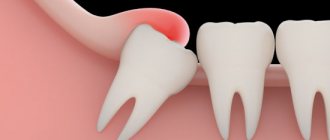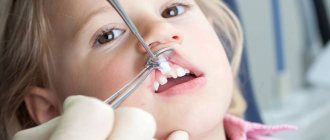A wisdom tooth is an ordinary tooth, the structure of which is no different from the multi-rooted other teeth. Doctors call wisdom teeth “eights,” because if all the teeth are conventionally divided into 2 symmetrical halves by a vertical line, then such teeth in the lower and upper dentition will be eighth in a row. Therefore, the answer to the question “how many wisdom teeth can a person grow” is four (one on each side, bottom and top). But this does not mean that all four wisdom teeth will necessarily erupt in every person. The whole reason is that during human development, the size of the jaws decreased significantly (by 10-12 mm). This is due to their transition to thermally processed, softer foods. Because of this, the chewing load on the jaw is reduced. As a rule, the rudiments of wisdom teeth can be found in all people, but in some people all 4 teeth erupt, while others do not even know if they have them at all.
At what age do wisdom teeth erupt?
Milk teeth are replaced by permanent teeth starting from the age of 6, this process ends around 12-13 years. The eruption of wisdom teeth most often occurs no earlier than 16-25 years of age. True, the literature describes cases where wisdom teeth erupted at the age of 40. But such cases are extremely rare.
Why did wisdom teeth get such a name?
Permanent teeth begin to erupt in a child at the age of 6-7 years, and the eruption of wisdom teeth occurs at the age of 16-25 years. It is by the age of 25 that the growth of all organs and systems of the human body, as well as their development, has completely ended, and then the process of aging of the body begins. Thus, the time when the eruption of the eighth teeth occurs can be considered the period of maturity of the organism, hence the last permanent eighth teeth got their name.
When do the extreme molars erupt? How long does the process take?
The appearance of third molars depends on the characteristics of the human body. According to statistics, the eighth teeth grow between the ages of 17 and 25 years. The absence of signs of growth of extreme molars should alert a person and cause him to contact specialists.
After many X-ray studies, it became known that third molars begin to form at the age of seven.
The growth and duration of the process, in turn, depend on hereditary factors, the general condition of the body and the structural features of the jaw.
The physiological process takes from several days to a month, and sometimes even several years. Some people erupt all their teeth at the same time, while others by the age of forty have only one or no outer molars at all.
Why do people need wisdom teeth?
As you know, in nature there is nothing superfluous. Although wisdom teeth are considered to be vestiges (parts of the body that have lost their function during the process of evolution), they can often be necessary in old age. The eighth teeth can serve as a support for bridge prosthetics, and also partially take over the chewing function if, for some reason, it becomes necessary to remove adjacent teeth. If wisdom teeth are healthy and correctly positioned, then they perfectly complement the dentition. But very often, “eights” can cause problems, because many complications arise during their eruption.
Content
- How wisdom teeth erupt
- Causes of difficulties
- The danger of late eruption
- How can wisdom teeth erupt faster?
- Negative consequences of late eruption
- Ways to get rid of problems
- Medicines
- Home method
- Surgery
Wisdom teeth are rudiments, organs that have lost their significance. They are the last to be cut, pushing the neighboring ones along the way. It is often accompanied by pain, so you have to see a doctor.
Complications that occur during the eruption of wisdom teeth
In some cases, various complications may arise during the eruption of wisdom teeth. Most often, inflammation of the tissues that are located around the tooth occurs. During the growth of a wisdom tooth, a mound appears on the surface of the gum, which is covered by a mucous membrane - the so-called “hood”. The wisdom tooth covered with this “hood” is subject to constant traumatization by solid food, due to which infection subsequently develops and inflammation develops. As a result of food debris getting under the “hood,” favorable conditions arise for the life of pathogenic flora, resulting in purulent inflammation—pericoronitis.
How long do eights grow?
The period for the last element to appear on the surface ranges from 4 weeks to 10 years. On average, patients may experience discomfort from the eruption of wisdom teeth for up to 1.5 months. After the crown appears, the discomfort subsides. Then there is a pre-formation stage, which can take up to 5–7 years. An element is considered formed after its roots appear, which can number from 3 to 5.
Only a doctor can decide whether to remove the problematic element or not. The main indications for surgical intervention are chronic pericoronitis, compression of the roots of an adjacent tooth by the figure eight, damage to the soft tissue of the gums on the crown of a molar. If there are no problems when cutting through the unit, then experts leave the eights untouched. These teeth are as important as all other elements, despite the fact that they do not take part in the digestion of food.
Squeezing an adjacent element with a figure eight
The last molars prevent the remaining teeth from moving to the side and prevent various malocclusions. When prosthetizing sevens, the last molars can be considered as a support for orthodontic structures. For this reason, doctors try to preserve the element even if it is damaged by caries.
Clinical picture of pericoronitis
The disease begins with increasing pain in the area of the wisdom tooth. The pain is very intense, it can radiate to the temple and ear. Pain may occur when opening the mouth, yawning, or swallowing. Sometimes you feel like your throat and cheek hurt, not your wisdom tooth. The process may also involve the facial muscles and lymph nodes. If a wisdom tooth becomes inflamed, the general condition of the whole body also suffers: a headache occurs and the temperature rises. The mucous membrane in the area of the diseased tooth is painful and red; as a result of “pressure” on the hood, pus may be released and swelling may occur.
What you should not do if your wisdom tooth is sick:
- Under no circumstances should you apply any heat to your cheek (including heating pads), or rinse your mouth with warm water. As a result of any warming, the infection can spread even more, even suppuration of the bone tissue is possible.
- It is not recommended to put painkillers on the tooth area, because as a result, not only will the pain not be relieved, but an ulcer may form on the gum.
- Under no circumstances should you use advice given by friends and relatives. This or that remedy can help them, but the exact cause and diagnosis are unknown, as a result of which your wisdom tooth is swollen.
Medicines
Using analgesics will eliminate the pain, but its source will remain. Use:
- Anti-inflammatory drugs to reduce fever and swelling (paracetamol, ketorolac, ibuprofen);
- Analgin and local anesthetics reduce tissue sensitivity;
- Antiseptics (miramistin, chlorhexidine) - act on pathogenic microorganisms.
What to do if your gums are inflamed
Contact your dental surgeon immediately. Before you plan to do this, you can take an anesthetic (ketorol, analgin, etc.) orally. It is advisable to rinse the oral cavity with a cold solution, which is prepared at the rate of 1 teaspoon of soda and the same amount of salt per glass of water.
Treatment of such a pathology consists of incision (opening) of the mucous “hood”, further washing of the cavity and taking anti-inflammatory and analgesic drugs. If a large amount of pus is removed during the autopsy, the patient must also take antibiotics. If the gums surrounding the wisdom tooth become inflamed again, then most often the dentist advises removing the wisdom tooth.
Caries
Carious lesions are another common problem that occurs during the eruption of wisdom teeth. The development of this pathology is due to the fact that the eighth teeth are located in a hard-to-reach place, which prevents good daily oral hygiene. Often, a wisdom tooth may erupt with initial signs of caries and damaged enamel. Due to the fact that such teeth are always pressed tightly against neighboring teeth, caries can quickly spread to them. In this case, after an examination, the dentist will decide whether the wisdom tooth can be treated or whether it is better to remove it.
Crowding of teeth and malocclusion
Due to the fact that there is usually not enough space for a growing wisdom tooth, it begins to prop up the adjacent molar and shift it towards the center, and it, in turn, also moves towards the center of the teeth adjacent to it. As a result, crowding of teeth occurs and their correct alignment is disrupted. If this process goes too far, the bite may be disrupted.
Pressure on the adjacent tooth
Quite often, as wisdom teeth grow, pain may occur (constant dull or intermittent), radiating to the ear, temple or lower jaw. If there are no external signs of inflammation (redness and swelling of the gums), then you need to take a photo of the tooth. After all, this is the only way to understand whether the wisdom tooth is growing correctly and whether it will be necessary to remove it.
Inflammation of the branches of the trigeminal nerve
The pathology is manifested by attacks of pain in the neck, as well as twitching of some muscles. Painful attacks can be triggered by normal daily activities such as washing, brushing teeth or shaving. Most often, the symptoms go away after the wisdom tooth is removed and proper anti-inflammatory treatment is administered.
Jaw cyst
Since the growth of a wisdom tooth occurs very slowly, it can cause the formation of a cyst in the lower jaw. In the event that the cyst does not grow, the course of the disease may be asymptomatic, and the cyst can be discovered by chance when a picture of the jaw is taken for completely different reasons. If the cyst grows, this causes pain in the area of the wisdom tooth. There may be an accumulation of fluid in the cyst, which will gradually corrode the walls of the teeth. If an infection gets into the cyst cavity, a gumboil (ulcer) of the wisdom tooth occurs. In this case, you can definitely answer that the “eight” must be removed.
Possible complications
Inflamed gums cause pain when chewing or swallowing, poor health and fever.
Pericoronitis is one of the serious complications that can occur during the eruption of third molars.
The disease is characterized by an inflammatory process that affects the tissue around the tooth.
Inflamed gums cause pain when chewing or swallowing, poor health and fever.
A characteristic feature of pericoronitis is the abundant proliferation of bacteria under the hood.
Around the third day, the disease becomes purulent. The patient complains of severe toothaches and pain radiating to the ear and temples, painful opening of the mouth.
The presence of pus under the formed hood causes intoxication of the body, which is manifested by high temperature. The patient has severe facial asymmetry on the side of the diseased tooth, pale face and inflammation of the lymph nodes.
Due to the proximity of the figure eight to the second molar, a small gap is formed in which food debris accumulates. The proliferation of bacteria in most cases leads to the appearance of caries.
A tooth that has already come out is considered the most convenient place for bacteria to multiply: its inconvenient location makes them difficult to clean. After some time, the gums become inflamed and swollen. Flux occurs with fever, severe pain and a swollen cheek.
When the upper tooth erupts, the trigeminal nerve may become inflamed, which is manifested by involuntary contraction of the facial muscles and sharp pain. With late therapy, facial paralysis may occur.
An abscess is a purulent disease that causes an unpleasant odor from the mouth, severe throbbing pain, a constant bitter taste and swelling.
When is it necessary to remove wisdom teeth?
Whether it is necessary to remove a wisdom tooth or not is the most common question that interests every person who is faced with the problematic eruption of “eights”. For wisdom tooth removal, as for any other surgical procedure, there are indications. Wisdom teeth are removed if:
- There are impacted “eights” - those that are incorrectly positioned in the jaw and cannot erupt, since they rest partially or completely on other teeth
- The “eight” has partially erupted, but there is pain and inflammation in the gums (recurrent pericoronitis).
- For pain along the trigeminal nerve.
- Presence of a mandibular cyst.
- Periodic pain in the area of the wisdom tooth, accompanied by headache, pain when swallowing or other painful conditions.
- Trauma to the oral mucosa as a result of improper tooth positioning.
Early signs
The appearance of the last unit is accompanied by more striking signs, since there was no milk predecessor in its place.
Among the characteristic signs of teething are:
- pain, which in the most difficult cases provokes loss of consciousness;
- increase in body temperature to 39-40 degrees (usually observed with the development of infectious complications);
- swelling of the soft tissues of the mouth - cheeks, palate, gums;
- inflammation of the bone structures of the jaw and its destruction under the influence of pathogenic flora;
- formation of ulcers in the oral cavity;
- enlarged lymph nodes under the jaw.
Consequences of wisdom teeth removal
In almost all cases, removal of wisdom teeth is traumatic, which can result in slow healing and various complications. Pain after such a procedure may occur due to alveolitis, an inflammatory process in the socket. Normally, the hole is covered by a blood clot, which protects the wound from pathogenic microbes entering it. That is why it is strictly forbidden to rinse your mouth after tooth extraction! When a blood clot is washed out, an infection may develop or a dry socket may occur, which may require further surgery. In some cases, after removal of the “eight”, numbness of the tongue, chin or lip may occur in the first days. If this condition does not go away within a week, you need to consult a doctor again, who will prescribe the necessary treatment.
How painful is wisdom teeth removal?
The question of the pain of wisdom tooth removal arises in all patients who need such an operation. The removal procedure is carried out under local anesthesia (various painkillers are used - ultracaine, septanest, ubistezin and others). The complexity of removal and pain depend on many factors: the structural features of the root system, the location of the tooth, the presence of complications in the form of cysts, suppuration and others, as well as the pain sensitivity threshold of a particular person.
What to do if your wisdom tooth hurts during pregnancy
Unfortunately, any pregnant woman may experience various unpleasant conditions and diseases. As with any other period, the eruption of wisdom teeth can occur during pregnancy and this can be a cause for concern. Many people wonder whether wisdom teeth can be treated during this period and how to deal with pain relief during this period. Gynecologists advise treating teeth (including “eights”) after the 16th week of pregnancy. It is during this period that all systems and organs of the fetus are already formed, so the use of painkillers will not negatively affect the child.
Folk remedies used to treat wisdom teeth
The following traditional medicine recipes will help reduce signs of gum inflammation and make teething less painful:
- The most common and simple method is rinsing the mouth with solutions of oak bark, sage, chamomile or soda solution.
- The inflamed gum above the figure eight can be lubricated with sea buckthorn oil.
- Rinsing the mouth with a decoction of chicory root. It has analgesic and anti-inflammatory effects. Add 1 tablespoon of chopped chicory root to 250 ml of boiling water and boil it all for 5 minutes. Then the broth is infused for 1 hour, after which you can use it to rinse the mouth 3-4 times a day.
- A saline solution with camphor and ammonia will have an analgesic effect. To prepare it, add 1 tablespoon of sea or table salt, 100 g of 10% ammonia and 10 g of camphor alcohol to 1 liter of cool boiled water. Shake everything well, then apply a cotton ball dipped in it to the teething site for 10-15 minutes. The procedure can be repeated several times a day.
Do not forget that any traditional medicine methods can only provide short-term relief, so do not hesitate to visit a dentist. Only a specialist will be able to answer you whether the wisdom tooth is growing correctly or not and whether there is a need for its removal.











